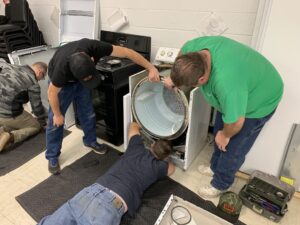Dishwashers have become an essential appliance in many households, making our lives easier by taking care of the tedious task of washing dishes. However, like any other appliance, dishwashers can experience problems from time to time. Knowing how to troubleshoot and fix these issues can save you time and money, as well as ensure that your dishwasher continues to work efficiently.
Key Takeaways
- Common dishwasher problems include clogged spray arms, dirty filters, and malfunctioning pumps.
- If your dishwasher won’t start, check the power source, door latch, and control panel for issues.
- To fix a dishwasher that isn’t cleaning dishes properly, clean the spray arms, unclog the dishwasher drain, and check the detergent dispenser.
- Leaking dishwashers may have issues with the door gasket, water inlet valve, or drain hose.
- Dishwasher drainage issues can be caused by clogged filters, drain hoses, or garbage disposals.
- Dishwasher cycle problems may be due to a faulty timer, thermostat, or motor.
- If your dishwasher isn’t working, check the power source, circuit breaker, and door latch before calling a repair technician.
- A broken dishwasher door may be caused by a faulty latch, hinge, or spring.
- Dishwasher noise and vibration can be reduced by leveling the dishwasher, replacing worn parts, and using sound insulation.
- Regular maintenance, such as cleaning the dishwasher interior and checking the water supply line, can prevent future malfunctions.
Common Dishwasher Problems and Solutions
There are several common problems that can occur with dishwashers. One of the most common issues is when the dishwasher won’t start. This can be frustrating, especially if you have a sink full of dirty dishes waiting to be cleaned. Other common problems include the dishwasher not cleaning dishes properly, leaking, drainage issues, cycle problems, power failure, broken door, and excessive noise and vibration.
How to Troubleshoot a Dishwasher That Won’t Start
If your dishwasher won’t start, there are a few steps you can take to troubleshoot the issue. First, check if the dishwasher is properly plugged into an electrical outlet and that the outlet is functioning. If it is plugged in and the outlet is working, check if the circuit breaker has tripped or if a fuse has blown. Resetting the circuit breaker or replacing the fuse may solve the problem.
If these steps don’t resolve the issue, check if the door latch is properly engaged. Sometimes, the dishwasher won’t start if the door is not closed and latched securely. Additionally, check if the control panel is locked or if any buttons are stuck. If so, unlocking the control panel or fixing stuck buttons may solve the problem.
Fixing a Dishwasher That Isn’t Cleaning Dishes Properly
If your dishwasher isn’t cleaning dishes properly, there are a few things you can do to fix the issue. First, check if there is any debris or food particles clogging the spray arms or the filters. Clean them thoroughly and ensure that they are free from any obstructions. Additionally, check if the water temperature is hot enough. The water should be at least 120 degrees Fahrenheit for optimal cleaning.
If the spray arms are not rotating properly, they may need to be cleaned or replaced. Sometimes, the spray arms can become clogged with debris or mineral deposits, preventing them from spinning and distributing water effectively. Cleaning or replacing the spray arms can help improve cleaning performance.
How to Diagnose and Repair a Leaking Dishwasher
A leaking dishwasher can cause damage to your kitchen floor and cabinets if not addressed promptly. To diagnose and repair a leaking dishwasher, start by checking the door gasket for any signs of wear or damage. If the gasket is worn or torn, it will need to be replaced. Additionally, check if the door latch is properly engaged and if the dishwasher is level. A misaligned dishwasher can cause water to leak out.
If the door gasket and latch are in good condition and the dishwasher is level, check if there are any cracks or leaks in the water supply line or drain hose. If you find any leaks, replace the damaged parts. It’s also important to check if the dishwasher is overfilled with detergent, as excessive suds can cause leaks. Adjusting the amount of detergent used can help prevent leaks.
Addressing Dishwasher Drainage Issues
If your dishwasher is not draining properly, it can leave standing water at the bottom of the tub and prevent your dishes from getting clean. To address drainage issues, start by checking if there are any clogs in the drain hose or air gap. Clearing any obstructions can help improve drainage.
If there are no visible clogs, check if the drain pump is working properly. The drain pump is responsible for pumping out the water from the dishwasher. If it is not functioning correctly, it may need to be replaced. Additionally, check if the dishwasher’s filter is clean. A dirty filter can restrict water flow and cause drainage problems. Cleaning or replacing the filter can help improve drainage.
Solving Dishwasher Cycle Problems
If your dishwasher is experiencing cycle problems, such as not completing a cycle or getting stuck in a cycle, there are a few things you can do to solve the issue. First, check if the control panel is locked or if any buttons are stuck. Unlocking the control panel or fixing stuck buttons may resolve the problem.
If the dishwasher is not completing a cycle, check if the water temperature is hot enough. The water should be at least 120 degrees Fahrenheit for optimal performance. Additionally, check if the spray arms are rotating properly and if the filters are clean. If the spray arms are not spinning or the filters are clogged, cleaning or replacing them can help improve cycle performance.
Restoring Power to a Dishwasher That’s Not Working
If your dishwasher is not working at all, it may be due to a power failure. To restore power to your dishwasher, start by checking if it is properly plugged into an electrical outlet and that the outlet is functioning. If it is plugged in and the outlet is working, check if the circuit breaker has tripped or if a fuse has blown. Resetting the circuit breaker or replacing the fuse may restore power to your dishwasher.
If these steps don’t resolve the issue, check if there are any loose or damaged wires in the dishwasher’s electrical system. If you find any loose connections or damaged wires, they will need to be repaired or replaced. It’s important to turn off the power to your dishwasher before attempting any electrical repairs.
Repairing a Broken Dishwasher Door
A broken dishwasher door can prevent your dishwasher from functioning properly and can also be a safety hazard. To repair a broken dishwasher door, start by checking if the door latch is properly engaged. Sometimes, the dishwasher won’t start if the door is not closed and latched securely. Adjusting the door latch or replacing it if necessary can help fix the issue.
If the door latch is in good condition and the door still won’t close properly, check if there are any obstructions preventing it from closing. Sometimes, dishes or utensils can get stuck in the door, preventing it from closing fully. Removing any obstructions can help fix the problem. If the door hinges are damaged or broken, they will need to be replaced.
Dealing with Dishwasher Noise and Vibration
Excessive noise and vibration from your dishwasher can be annoying and disruptive. To deal with dishwasher noise and vibration, start by checking if the dishwasher is level. A misaligned dishwasher can cause excessive noise and vibration. Adjusting the leveling feet can help reduce noise and vibration.
If the dishwasher is level and still making noise, check if there are any loose or worn parts. Tightening loose screws or replacing worn parts, such as the spray arms or pump motor, can help reduce noise and vibration. Additionally, check if there are any foreign objects, such as utensils or broken glass, stuck in the dishwasher’s pump or spray arms. Removing any obstructions can help improve performance and reduce noise.
Maintaining Your Dishwasher to Prevent Future Malfunctions
Regular maintenance is essential to keep your dishwasher running smoothly and prevent future malfunctions. Some tips for maintaining your dishwasher include cleaning the filters regularly, checking for clogs in the drain hose and air gap, running a vinegar rinse cycle to remove mineral deposits, and inspecting the door gasket for wear or damage.
It’s also important to use the correct amount of detergent and rinse aid to prevent buildup and clogs. Avoid overloading your dishwasher, as this can affect its performance. Additionally, periodically check for leaks and address them promptly to prevent water damage.
In conclusion, knowing how to troubleshoot and fix common dishwasher problems can save you time, money, and frustration. By following the step-by-step guides and implementing the possible solutions provided in this article, you can address issues such as a dishwasher that won’t start, isn’t cleaning dishes properly, is leaking, has drainage problems, cycle problems, power failure, a broken door, excessive noise and vibration, and more. Regular maintenance is also crucial to prevent future malfunctions and keep your dishwasher running efficiently.
Can I Use the Step-by-Step Repair Guide to Fix Dishwasher Malfunctions?
Yes, you can use the step by step dishwasher repair guide to fix common malfunctions. The guide provides detailed instructions on troubleshooting and repairing issues like leaks, inefficient cleaning, and strange noises. Following the step by step instructions can help you diagnose and fix the problem with your dishwasher.
FAQs
What are some common dishwasher malfunctions?
Some common dishwasher malfunctions include not cleaning dishes properly, not draining water, making strange noises, and leaking water.
What causes a dishwasher to not clean dishes properly?
A dishwasher may not clean dishes properly due to clogged spray arms, a malfunctioning pump or motor, or a faulty detergent dispenser.
What should I do if my dishwasher is not draining water?
If your dishwasher is not draining water, you should check for clogs in the drain hose or garbage disposal, clean the dishwasher filter, and ensure that the dishwasher is level.
Why is my dishwasher making strange noises?
A dishwasher may make strange noises due to a malfunctioning motor or pump, loose or worn parts, or a clogged spray arm.
How can I fix a leaking dishwasher?
To fix a leaking dishwasher, you should check for loose or damaged hoses, a faulty door gasket, or a damaged tub. You may need to replace these parts to stop the leak.



